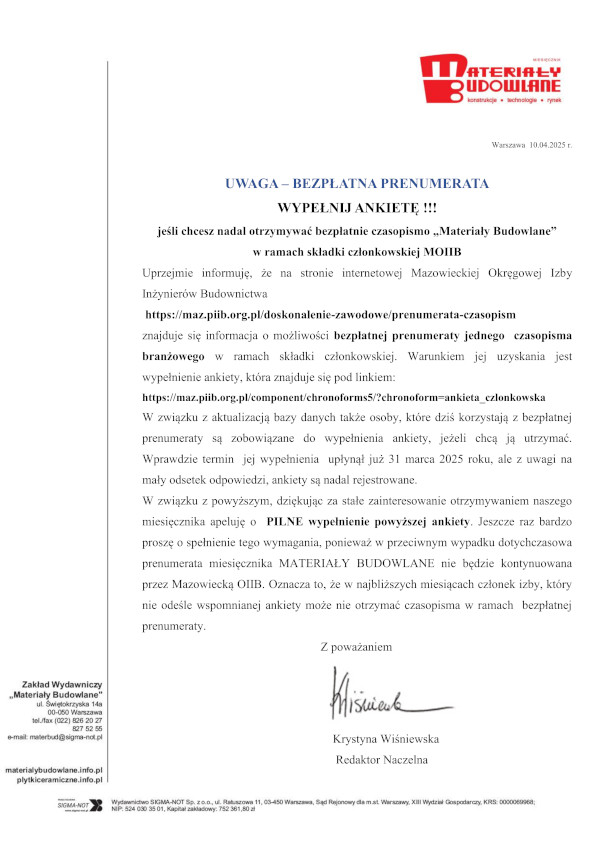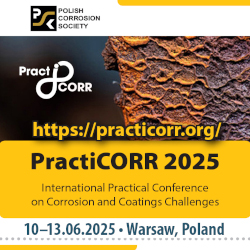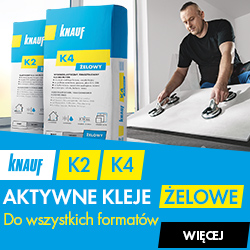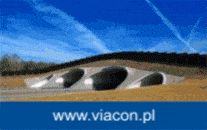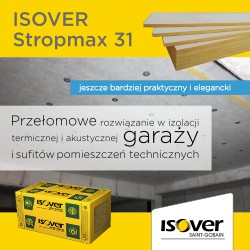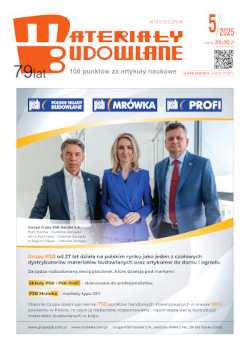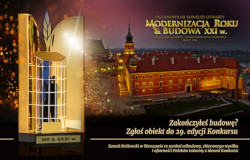dr inż. Danuta Barnat-Hunek Politechnika Lubelska,Wydział Budownictwa i Architektury
dr inż. Piotr Smarzewski Politechnika Lubelska,Wydział Budownictwa i Architektury
Autor do korespondencji: e-mail: Ten adres pocztowy jest chroniony przed spamowaniem. Aby go zobaczyć, konieczne jest włączenie w przeglądarce obsługi JavaScript.
DOI: 10.15199/33.2015.10.39
W artykule omówiono zagadnienia dotyczące zwilżalności warstwy wierzchniej hydrofobizowanego keramzytobetonu. Wczęści doświadczalnej określono wpływ trzech preparatów hydrofobowych na swobodną energię powierzchniową (SEP) betonu.Wyznaczono kąt zwilżania betonu (θ) przy użyciu dwóch cieczy pomiarowych –wody destylowanej i gliceryny, a następnie wykorzystując metodę Owensa-Wendta, składową dyspersyjną i polarną SEP oraz jej wartość sumaryczną.
Słowa kluczowe:
swobodna energia powierzchniowa (SEP), kąt
zwilżania, hydrofobizacja, keramzytobeton
* * *
Evaluation of the contact angle and surface free energy of hydrophobised lightweight aggregate concrete
The article discusses issues related to the wettability of hydrophobised lightweight aggregate concrete surface layer. In the experimental part, the influence of three hydrophobic preparations on the concrete surface free energy (SFE). In order to examine the concrete contact angle (θ), two measuring liquids were used – distilled water and glycerine, and then the Owens – Wendt method used to determine dispersion component, polar component, and total SFE value.
Keywords: surface free energy (SFE), contact angle, hydrophobisation, lightweight aggregate concrete.
Literatura :
[1] Aldred J. M., Swaddiwudhipong S., Lee S. L., Wee T. H., The effect of initial moisture content on water transport in concrete con taining a hydro phobic admixture, Mag. Concr. Res. 53 (2) (2001) 127 – 134.
[2] Demirbo R, Gül R. The effects of expanded perlite aggregate, silica fume and Elyash on the thermal conductivity of lightweight concrete. Cem Concr Res 2003; 33 (5): 723 – 7.
[3] Kim H. K., Jeon J. H., Lee H. K.: Workability, and mechanical, acoustic and thermal proper ties of lightweight aggregate concrete with a high volume of entrained air. Construc tion and Building Materials 29 (2012) 193 – 200.
[4] Kaszyńska M.: Lekkie betony samo zagęszczalne do konstrukcji mostowych. Mosty, marzec – kwiecień 2009.
[5] Mechtcherine V., Haist M., Hewener A., Mueller H. S.: Self compacting lightweight concrete a new high-performance building material. The first fib Congress, Conference proceedings, Osaka 2002.
[6] Frattolillo A., Giovin co G., Mascolo M. C., Vitale A., Effects of hydrophobic treatment on thermo physical properties of lightweight mortars, Exp. Therm. Fluid Sci. 29 (6) (2005) 733 – 741.
[7] Czarnecki L.: Betony polimerowe. Cement Wapno Beton, marzec-kwiecień nr 2/2010 r.
[8] Zhu Y.-G., Kou S.-C., Poon C.-S., Dai J.- G., Li Q.-Y.: In fluence of silane-based water repellent on the durability properties of recycled aggregate concrete. Cement and Concrete Composites 35 (2013), 32 – 38 DOI: 10.1016/j. cemconcomp. 2012.08.008
[9] Rudawska A.: Wybrane zagadnienia konstytuowania połączeń adhezyjnych jednorodnych i hybrydowych. Monografie – Politechnika Lubelska, Lublin 2013.
[10] PN -EN 828:2000 – Kleje. Oznaczanie zwilżalności poprzez pomiar kątazwilżania i krytycznego napięcia powierzchniowego ciała stałego.
[11] Lugscheider E., Bobin K.: The influence on surface free energy of PVD-coatings. Surface Coatings Technology, 2001, 142 – 144, 755 – 760.
[12] Vedantam S., Panchagnu la M. V.: Constitutive modeling of contact angle hysteresis. Journal of Colloid and Interface Science, 2008, 321, 393 – 400.
[13] Zielecka M.: Methods of contact angle measurement as a tool for characterization of wettability of polymers. Polimery, 2004, 49, 327 – 332.
[14] Shang J., Flury M., Harsh J. B., Zollars R. L.: Comparison of different methods to measure contact an gles of soil colloids. Journal of Colloid and Interface Science, 2008, 328, 299 – 307.
[15] Żenkiewicz M.: Analiza głównych metod badania swobodnej energii powierzchniowej materiałów polimerowych. Polimery, 2007, 52, 760 – 767.
[16] Ahadian S., Mohseni M., Morawian S.: Ranking proposed models for at taining surface free energy of powders using contact angle measurements. International Journal of Adhesion and Adhesives, 2009, 29, 458 – 469.
[17] Rudawska A., Jacniac ka E.: Analysis of Determining Surface Free Energy Uncertainty with the Owens-Wendt method. International Journal of Adhesion and Adhesives, 2009, 29, 451 – 457.
.
Otrzymano: 12.04.2015 r.
Materiały Budowlane 10/2015, str. 128-130 (spis treści >>)


